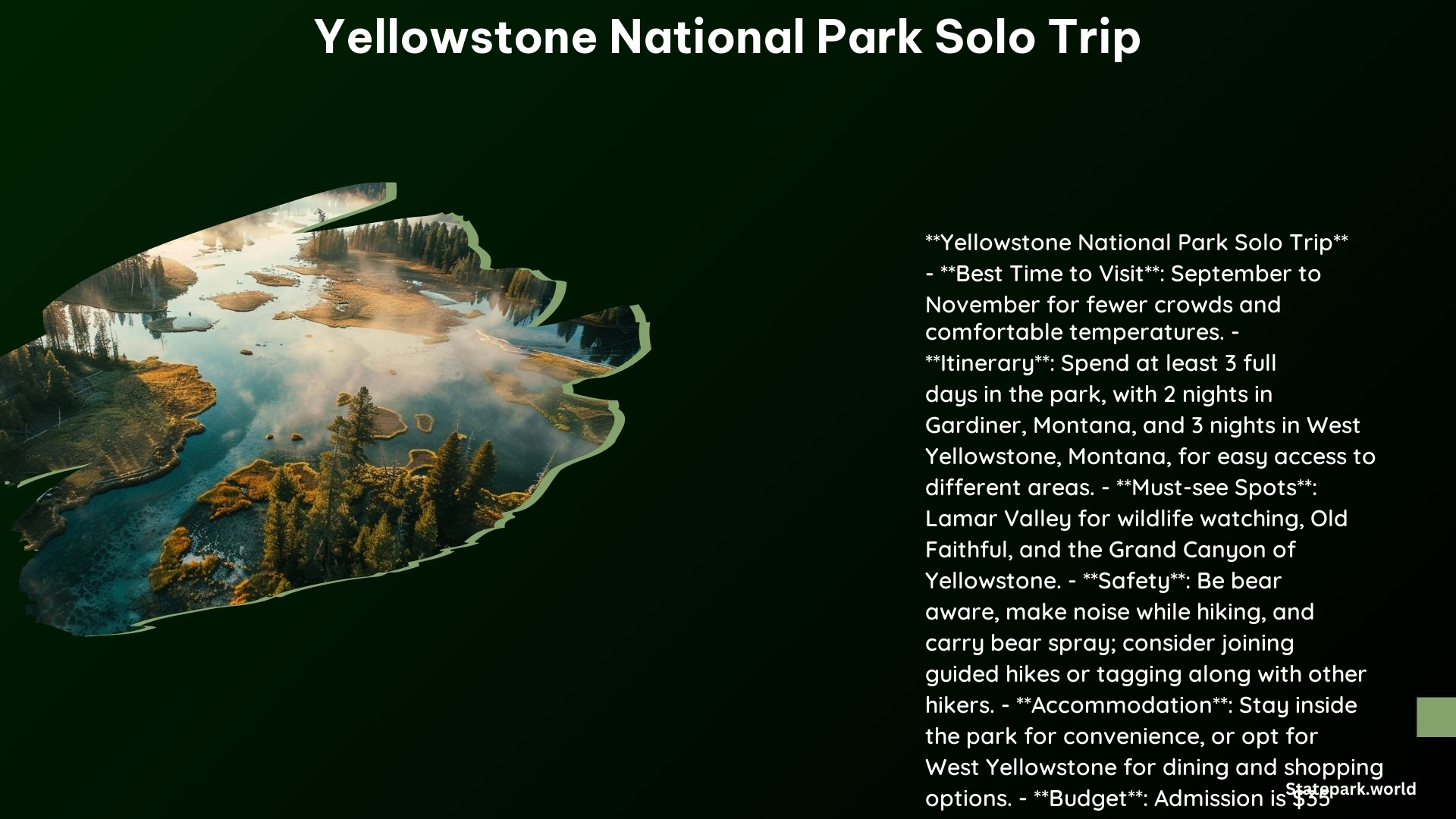Planning a solo trip to Yellowstone National Park can be a rewarding and unforgettable experience. As a National Park touring enthusiast, you’ll have the opportunity to immerse yourself in the park’s stunning natural beauty, diverse wildlife, and rich history, all while enjoying the freedom and flexibility of traveling on your own.
Safety Tips for Solo Travelers in Yellowstone National Park
-
Bear Awareness: Yellowstone is bear country, so it’s essential to be bear aware. Make noise while hiking, carry bear spray, and let someone know your itinerary and expected return time. Avoid hiking alone in remote areas, especially at dawn, dusk, or night when bears are most active.
-
Hiking with Others: If you need to hike alone, consider joining a guided ranger hike or waiting for other hikers to join you. This can help ensure your safety in bear-prone areas.
-
Stay Connected: Although cell signal may be limited, consider carrying a paper map or downloading a map to your phone before heading out on a hike. This can help you stay on track and communicate if needed.
-
Be Prepared: Always carry the 10 hiking essentials, including plenty of water, and be prepared for changing weather conditions.
Best Spots for Wildlife Watching During a Solo Trip to Yellowstone National Park

-
Lamar Valley: Known for its abundant wildlife, including bison, wolves, coyotes, and more. Bring binoculars and a camp chair to enjoy the scenery during sunrise or sunset.
-
Hayden Valley: Another prime spot for wildlife viewing, including bison, elk, and bears.
-
Moose-Wilson Road: In Grand Teton National Park, this road is ideal for spotting wildlife such as moose, bears, deer, and elk during sunrise or sunset.
Planning Your Solo Trip to Yellowstone National Park
-
Duration: Spend at least three full days in the park to fully appreciate its natural diversity.
-
Accommodation: Consider staying in or near the park to minimize travel time and ensure you can enjoy the park during the best times of day. Gardiner and West Yellowstone are good options for accessing different parts of the park.
-
Transportation: Flying into Bozeman and driving to the park is a convenient option. If you’re nervous about mountainous roads, the north entrance through Gardiner is considered the easiest drive.
-
Cost: A 7-day pass to the park costs $35, making it an affordable trip for solo travelers. Camping inside the park starts at $20 per night, which is cheaper than many RV or state park campgrounds.
-
Guided Tours: If you prefer a more structured experience, consider joining a guided tour specifically designed for solo travelers. These tours can range from 4 to 8 days and offer a variety of activities and accommodations.
Additional Tips and Resources
- Maps and Itineraries: Plan your trip using maps and itineraries to ensure you make the most of your time in the park. Websites like TourRadar and TripAdvisor offer valuable resources and reviews from other travelers.
- Weather: Be prepared for changing weather conditions, especially in the higher elevations. Summer is the best time for driving conditions, but autumn can offer beautiful scenery with fewer crowds.
By following these tips and guidelines, you can have a safe and enjoyable solo trip to Yellowstone National Park, immersing yourself in the park’s natural wonders and creating unforgettable memories as a National Park touring enthusiast.
References:
– https://solowomenrv.com/5-reasons-to-visit-yellowstone-as-a-solo-traveler-2/
– https://www.reddit.com/r/yellowstone/comments/s6lwt4/how_to_plan_a_solo_trip_to_yellowstone/
– https://www.tourradar.com/s/v-singles-national-park-yellowstone-national-park
– https://allisonanderson.com/blog/my-solo-trip-to-wyoming-yellowstone-and-grand-teton-national-parks
– https://www.tripadvisor.com/ShowTopic-g60999-i481-k10882673-Traveling_alone_to_Yellowstone-Yellowstone_National_Park_Wyoming.html
